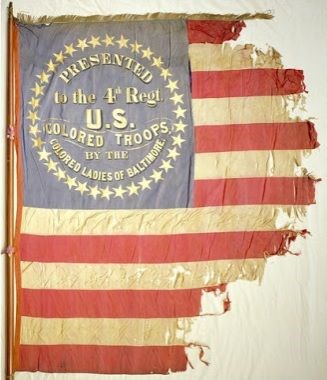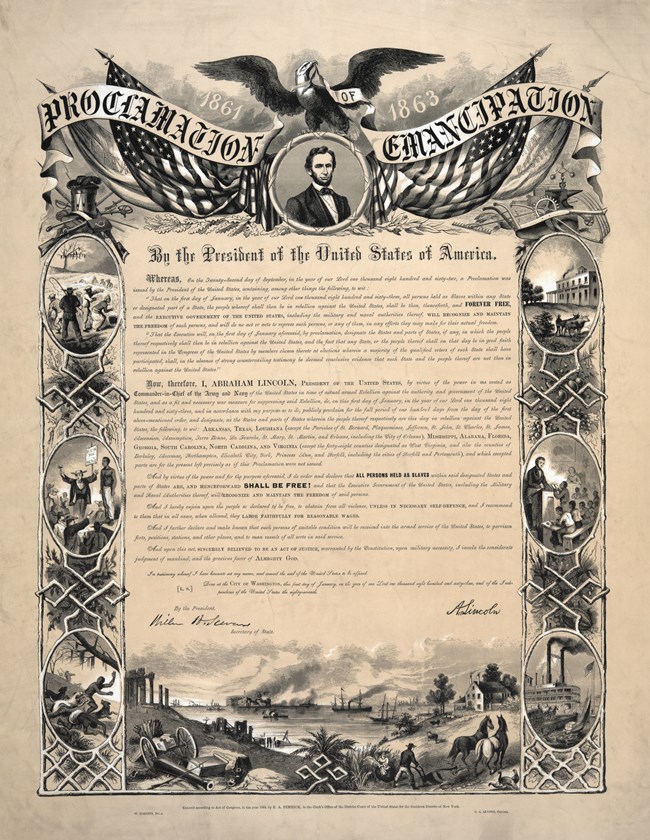
The United States Colored Troops, or USCT, were African American men who fought for the United States and freedom during the American Civil War. The tradition of military service by men of color dates back to before the American Revolution and it is no surprise that many saw the war as an oppertunity to strike against the institution of slavery. "...the contest must now be decided, and decided forever, which of the two, Freedom or Slavery, shall give law to this republic. Let the conflict come, and God speed the right..." - Frederick Douglass, 18611 The laws of the United States at the opening of the Civil War however, forbade the use of African Americans in combat. While there were some provisions for non-combat roles in the Navy, the majority of African Americans were barred from enlisting, even those who had experience from serving in northern militias. This began to change in August 1861 with the Confiscation Act of 1861. This allowed Federal forces to sieze property, which included enslaved individuals, that were being used to support the rebellion.2 This legal loop hole allowed thousands of the formally enslaved to flock to the camps of United States forces as they pressed further into the territory claimed by the Confederacy. The army utilized this glut of manpower by employing these men and women as laborers, teamsters, seamstresses and laundresses, among many other jobs. In December 1861, the Confiscation Act of 1862 was introduced to Congress. This was a much more expansive document than its predecessor, allowing the President of the United States: "... to employ as many persons of African descent as he may deem necessary and proper for the suppression of this rebellion, and for this purpose he may organize and use them in such manner as he may judge best for the public welfare." - Section 11, Confiscation Act of 18623 Radified on July 17, 1862, this document began the process of allowing African Americans to fight for their own freedom. That summer several regiments of African American soldiers began to be raised, particularly out west and in Union controlled territories in the South, such as Kanasas, Louisiana and Mississippi. With the process begun, the formal establishment of the United States Colored Troops was soon to follow. 
When the Emancipation Proclomation was signed on January 1, 1863 this document not only called for the abolition of slavery in those states still in rebellion, but also for the arming of African-American's for service in the Army and Navy. Though this had been legal since the summer of 1862, the Emancipation Proclamation was an announcement to the world that slavery would soon be at its end and that the formally enslaved and free men of color would help see to that. The United States Bureau of Colored Troops was formally established on May 22, 18635. To help raise and organize this vast supply of man power, recruiting stations were established throughout the Northern and Border States. One such recruiting station was here at Monocacy Junction, just south of Frederick, Maryland. By the end of the American Civil War at least 540 men had been placed on the muster rolls from Frederick County and sent to enlist in a wide range of units. These included some of the most famous regiments to the war, such as the 54th and 55th Massachusetts Infantry, as well as those less known, like the 4th United States Colored Troops, 3rd United States Colored Cavalry and the 8th United States Heavy Artillery. 1 David W. Blight, Frederick Douglass: Prophet of Freedom, (New York, NY: Simon & Schuster, 2018), 336 2. "The Confiscation Acts of 1861 and 1862", The United States Senate, accessed 11/1/2021, U.S. Senate: The Confiscation Acts of 1861 and 1862 3 "The Second Confiscation Act - 1862", Abraham Lincoln Historical Society, accessed 11/1/2021, The Second Confiscation Act – 18624 Ira Berlin, Joseph Reidy & Leslie Rowland, Freedom's Soldiers: The Black Military Experiance in the Civil War, (Cambridge: UK, Cambridge University Press, 1998), vii 5 Oliver Diefendorf, Thomas M.O'Brien, General Orders of the War Department, Embracing the Years 1861, 1862 & 1863, (New York: NY, Derby & Miller, 1864), 157 |
Last updated: April 18, 2022
